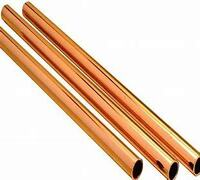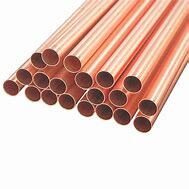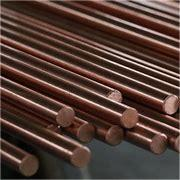1. Introduction
Copper prices have surged again—up over 4% in the past 48 hours due to tightening supply and rising demand in renewable energy infrastructure, according to the latest LME (London Metal Exchange) report. This spike is making headlines across manufacturing and construction sectors, where copper rod and related products like copper strips and pipes are essential. Whether you’re an electrician, welder, plumber, or scrap recycler, understanding the full spectrum of copper rod applications has never been more valuable.

In this guide, we’ll walk you through everything you need to know about copper rod—from its role in grounding systems to welding, earthing, and even scrap recycling. We’ll also clarify confusing terms like ‘rod copper’ versus ‘copper round bar’ and explain why copper bonded and copper clad variants dominate the market today.
2. What Is a Copper Rod?
A copper rod is a solid, cylindrical metal bar made primarily of high-conductivity copper. It’s used across electrical, mechanical, and thermal applications thanks to copper’s excellent conductivity, corrosion resistance, and malleability.
Common types include:
- Pure copper rod (often called copper round bar or round bar copper)
- Copper bonded earthing rod (steel core with copper coating)
- Copper clad steel ground rod (similar to bonded but with metallurgical bonding)
- Copper brazing rod and copper welding rod for joining metals
These rods vary in diameter, length, and alloy composition based on their intended use.
3. Copper Rods in Electrical Earthing and Grounding
One of the most critical uses of copper rod is in electrical safety systems. An earthing rod copper—also called a ground rod copper or copper earth rod—dissipates fault currents safely into the earth.
While solid copper rods offer the best performance, they’re expensive. That’s why copper bonded earthing rods and copper clad earth rods are popular alternatives. These combine a steel core (for strength) with a thick copper layer (for conductivity and corrosion resistance).
Key terms you’ll encounter include:
- Copper bonded steel
- Copper clad steel ground rod
- Copper clad steel earth rod
When shopping, compare earthing rod price and longevity—copper bonded options typically last 20+ years in most soils.
4. Copper Rods for Welding and Brazing
Not all copper rods are for grounding. Many are designed specifically for metal joining. A copper brazing rod or copper welding rod is used to fuse copper components without melting the base metal (brazing) or with it (welding).

For copper-to-copper joints, professionals often use copper to copper brazing rods or copper to copper welding rod formulations that ensure strong, leak-free connections—especially in HVAC and plumbing.
Popular choices include:
- Copper rod for welding in refrigeration lines
- Welding rod copper with phosphorus for self-fluxing properties
- Copper rod welding alloys for high-strength applications
Always match the rod composition to your base metal to avoid weak joints or corrosion.
5. Copper Strips: The Flat Cousin of the Copper Rod
While rods are round, copper strips are flat and flexible—ideal for busbars, earthing straps, and electronics. You’ll see terms like copper strip, flat copper strip, thin copper strips, and even niche items like copper tape for snails (used in garden pest control!).
Common variants include:
- Beryllium copper strip (high strength, used in springs)
- Nickel plated copper strip (enhanced corrosion resistance)
- Copper alloy strip (custom properties for industrial use)
For electrical earthing, a copper earth strip 25x3mm is standard, and copper strip price varies by thickness—e.g., 1mm copper strip costs less than thicker gauges.
If you’re sourcing locally, search ‘copper strip near me’ or look for a roll of copper strip for bulk projects.
6. Copper Rod Price and Market Trends
With copper hitting $9,200/ton this week, copper rod price and copper ingot price are climbing. This affects everything from copper bars for sale to ac copper pipe price.
Factors influencing cost:

- Purity (ETP copper vs. alloys)
- Form (solid vs. copper bonded)
- Quantity (bulk orders reduce per-unit cost)
Keep an eye on copper bar top suppliers and check copper ingot price weekly if you’re budgeting large projects.
7. Copper Pipes and Tubing: Related but Different
Though not rods, copper pipes often get grouped with copper rod discussions—especially in HVAC and plumbing. Aircon copper pipe, 15mm copper pipe, and 22mm copper tube are standard sizes.
Key considerations:
- Copper pipe sizing affects flow and pressure
- Bending copper pipe requires proper tools to avoid kinks
- Copper pipe soldering is the go-to joining method (resoldering copper pipe is common in repairs)
Note: PEX plumbing pipes are replacing copper in some residential uses, but copper remains king in AC lines and high-temp applications.
8. Scrap and Recycling: Stripping Copper Wire
With copper prices high, stripping copper wire for scrap is more profitable than ever. But burning copper wire for scrap is illegal in many areas and damages the metal.
The best way to strip copper wire includes:
- Using a manual or automatic wire stripper
- Avoiding heat to preserve purity
- Sorting by grade (e.g., bare bright vs. insulated)
For large-scale operations, the fast way to strip copper wire involves industrial machines. Always follow local regulations when stripping wire for recycling.
9. Flexible and Specialty Copper Products
Beyond rods and strips, flexible copper bar and flexible copper bus bar are gaining traction in EVs and data centers where vibration resistance matters.
Other niche products:
- Copper edging strip (for roofing and architecture)
- Copper roof strip (anti-moss and aesthetic)
- Copper strip wire (for custom windings)
These may cost more but offer unique functional benefits.
10. Conclusion
From copper rod welding to copper bonded ground rods and flat copper strips, this versatile metal remains indispensable across industries. With copper prices trending upward and global demand growing—especially in green tech—understanding the differences between rod copper, copper clad variants, and related products helps you make smarter, cost-effective decisions. Whether you’re installing an earthing system, repairing AC lines, or recycling scrap, knowing your copper forms pays off—literally.
Our Website founded on October 17, 2012, is a high-tech enterprise committed to the research and development, production, processing, sales and technical services of ceramic relative materials such as 10. Our products includes but not limited to Boron Carbide Ceramic Products, Boron Nitride Ceramic Products, Silicon Carbide Ceramic Products, Silicon Nitride Ceramic Products, Zirconium Dioxide Ceramic Products, etc. If you are interested, please feel free to contact us.

